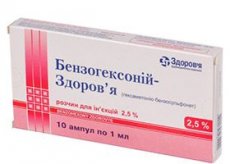Medical expert of the article
New publications
Preparations
Benzohexonium
Last reviewed: 03.07.2025

All iLive content is medically reviewed or fact checked to ensure as much factual accuracy as possible.
We have strict sourcing guidelines and only link to reputable media sites, academic research institutions and, whenever possible, medically peer reviewed studies. Note that the numbers in parentheses ([1], [2], etc.) are clickable links to these studies.
If you feel that any of our content is inaccurate, out-of-date, or otherwise questionable, please select it and press Ctrl + Enter.

Indications Benzohexonium
Indications for its use include: a sharp and rapid increase in blood pressure (hypertensive crisis), as well as artificially lowering blood pressure under control (controlled hypotension).
 [ 4 ]
[ 4 ]
Pharmacodynamics
The drug is a ganglionic blocker that blocks n-cholinergic receptors located in the autonomic ganglia, and in addition, slows down the process of nerve impulse conduction (from preganglionic to postganglionic endings). At the same time, it suppresses carotid bodies and adrenal chromaffin tissue, which reduces the resulting reflex pressor effect. It provokes a decrease in intestinal motility, blood pressure, urea tone, external secretion, and paresis of accommodation. In addition, it accelerates the heart rate and dilates the bronchi.
Pharmacokinetics
The drug is slowly and incompletely absorbed in the intestine, so it is usually administered parenterally. The active substance does not pass through the placenta and the BBB.
After intravenous administration, the plasma concentration level decreases very quickly. Up to 90% of the drug is excreted in the urine immediately during the first day. The rate of excretion in the first few hours after the injection is the highest.
 [ 8 ]
[ 8 ]
Dosing and administration
When taken orally, the dosage is 2-3 times a day, 0.1-0.2 g of the drug (the frequency of administration may be higher).
To eliminate a hypertensive crisis, the solution should be administered intramuscularly and subcutaneously at a dosage of 0.5-1.0 ml. A single dosage cannot exceed 0.3 g, and the daily dosage should not exceed 0.9 g. With the subcutaneous method of administration, a single dosage should not exceed 0.075 g, and the daily dosage should not exceed 0.3 g.
In case of controlled hypotension, the drug is administered intravenously (over 2 minutes) in a dosage of 1-1.5 ml. The drug begins to act after 12-15 minutes. If necessary, the solution can be administered additionally.
Use Benzohexonium during pregnancy
Benzohexonium should not be prescribed during lactation or pregnancy.
Contraindications
Among the contraindications:
- severe intolerance to drug components;
- low blood pressure;
- hypovolemia, as well as shock;
- acute myocardial infarction;
- pheochromocytoma;
- ischemic stroke (no more than 2 months);
- the presence of thrombosis (also inside the cerebral arteries);
- closed-angle glaucoma;
- kidney or liver failure;
- the presence of degenerative changes in the central nervous system.
 [ 9 ]
[ 9 ]
Side effects Benzohexonium
The following side effects are possible as a result of using the medicine:
- CNS organs: the appearance of dizziness or a feeling of weakness, the development of mydriasis or dysarthria, short-term memory impairment, as well as respiratory depression;
- cardiovascular system: development of tachycardia, pain in the heart, increased pulse rate, orthostatic hypotension (may lead to collapse), and also injection of the vessels of the eye sclera;
- Gastrointestinal organs: constipation, dry mouth, difficulty swallowing. With prolonged use, intestinal atony and gallbladder paresis may develop;
- urinary system organs: after prolonged use – atony of the bladder or urinary function disorder, in which urine stagnation is observed, contributing to the development of cystitis.
Overdose
Overdose may result in orthostatic collapse.
To eliminate the disorder, the patient should be given the following position - head down and legs up. Then weak doses of fetanol, mesaton or ephedrine, as well as caffeine and cordiamine are administered.
Interactions with other drugs
Antagonists of the drug are drugs that induce vomiting, cholinesterase inhibitors, and also n-cholinergic stimulants.
Benzohexonium enhances the effect of antihistamines and adrenomimetic drugs, as well as sleeping pills and sedatives, as well as antipsychotics and opiates. In addition to these drugs, it increases the effectiveness of tricyclics, local anesthetics, vasodilators and other hypotensive drugs.
Increases insulin intolerance in patients with diabetes.
Storage conditions
The medicine should be kept in the original, tightly sealed packaging. The room temperature should not exceed 25 o C.
 [ 21 ]
[ 21 ]
Shelf life
Benzohexonium is suitable for use for 4 (solution) and 5 (tablets) years from the date of manufacture.
Attention!
To simplify the perception of information, this instruction for use of the drug "Benzohexonium" translated and presented in a special form on the basis of the official instructions for medical use of the drug. Before use read the annotation that came directly to medicines.
Description provided for informational purposes and is not a guide to self-healing. The need for this drug, the purpose of the treatment regimen, methods and dose of the drug is determined solely by the attending physician. Self-medication is dangerous for your health.

